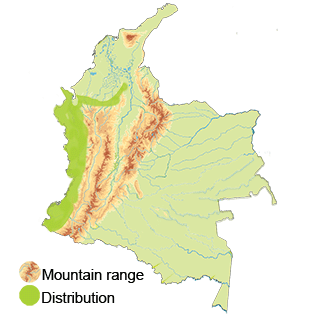Tooth-billed Hummingbird
Appearance: The most notable feature of the Tooth-billed Hummingbird is its elongated, curved bill, which sets it apart from other hummingbirds. This specialized bill shape is adapted for feeding on nectar from specific flowers with long corollas. They exhibit iridescent colors in its plumage, often showcasing shades of green and blue. This iridescence is a result of the structural properties of the feathers that reflect light in unique ways. The Tooth-billed Hummingbird has a white throat or chest, adding contrast to its overall appearance. They have a slightly forked tail, which can aid in agile flight maneuvers and stabilization during hovering and feeding.
Habitat: The Tooth-billed Hummingbird is found in the humid montane forests of the Andes mountains . These forests provide the bird with the necessary floral resources and elevation for its feeding, breeding, and nesting requirements.
Behavior: This species exhibits common hummingbird behaviors such as hovering while feeding on nectar, aggressive defense of feeding territories, and fast aerial displays during courtship. The Tooth-billed Hummingbird is known for its specialized feeding habits, relying on certain flowers with long corollas that match the length of its curved bill.
Breeding: Breeding habits of the Tooth-billed Hummingbird include courtship displays, nest building, and raising young. These birds breed during specific times of the year when resources are plentiful and environmental conditions are favorable.
Conservation Status: The Tooth-billed Hummingbird is listed as near-threatened by the International Union for Conservation of Nature (IUCN).
Distribution
The Tooth-billed Hummingbird (Androdon aequatorialis) is primarily found in the montane forests of the Andes mountains in Colombia.
These montane forests are typically located at higher elevations, where the climate is cooler and more humid compared to lower elevations. The Andean region in Colombia offers a diverse array of microclimates and ecosystems that support a rich variety of bird species, including the Tooth-billed Hummingbird.
The specific regions within the Colombian Andes where the Tooth-billed Hummingbird is likely to be found may include areas within departments such as Antioquia, Caldas, Risaralda, Tolima, and Boyacá, among others. These regions offer a mix of habitats, such as cloud forests, humid montane forests, and páramo ecosystems, that provide suitable environments for this unique hummingbird species.
Taxonomy
The Tooth-billed Hummingbird (Androdon aequatorialis)
- Kingdom: Animalia
- Phylum: Chordata
- Class: Aves (Birds)
- Order: Caprimulgiformes
- Family: Trochilidae
- Genus: Androdon
- Species: Androdon aequatorialis





